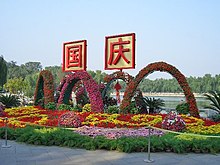
Back Çin bayramları Azerbaijani Fête chinoise French 中華人民共和国#祝祭日 Japanese 중화인민공화국의 공휴일 Korean Feriados na China Portuguese Праздники Китайской Народной Республики Russian Çin'deki resmî tatiller Turkish Свята Китайської Народної Республіки Ukrainian Xitoy Xalq Respublikasining bayramlari Uzbek 中华人民共和国节日与公众假期 Chinese
There are currently seven official public holidays on Mainland China.[1] Each year's holidays are announced about three weeks before the start of the year by the General Office of the State Council. A notable feature of mainland Chinese holidays is that weekends are usually swapped with the weekdays next to the actual holiday to create a longer holiday period.
| Date | Length (without weekends) | English name | Chinese name (Simplified) | Pinyin | Remarks |
|---|---|---|---|---|---|
| 1 January | 1 day | New Year's Day | 元旦 | Yuándàn | |
| 1st day of 1st Lunisolar month | 3 days (Chinese New Year's Eve, 1st and 2nd days of 1st Lunisolar month) | Spring Festival[a] (aka Chinese New Year) | 春节 | Chūnjié | Usually occurs in late January or early February. The most important holiday, celebrating the start of a new year |
| 5 April (4 or 6 April in some years) | 1 day | Tomb-Sweeping Day | 清明节 | Qīngmíng jié | Occurs about 15 days after the March Equinox; day for paying respect to one's ancestors |
| 1 May | 1 day | Labour Day | 劳动节 | Láodòng jié | International Workers' Day |
| 5th day of 5th Lunisolar month | 1 day | Dragon Boat Festival | 端午节 | Duānwǔ jié | Usually occurs in June; commemoration of the ancient poet Qu Yuan |
| 15th day of 8th Lunisolar month | 1 day | Mid-Autumn Festival | 中秋节 | Zhōngqiū jié | Usually occurs in September; important autumn celebration of harvest and togetherness |
| 1 October | 3 days[2] | National Day | 国庆节 | Guóqìng jié | Commemorating the formal proclamation of the establishment of the People's Republic of China on 1 October 1949 |

- ^ "PUBLIC HOLIDAYS". english.www.gov.cn. Retrieved 2021-09-23.
- ^ "National Day | Definition, History, & Facts | Britannica". www.britannica.com. Retrieved 2022-10-06.
Cite error: There are <ref group=lower-alpha> tags or {{efn}} templates on this page, but the references will not show without a {{reflist|group=lower-alpha}} template or {{notelist}} template (see the help page).
© MMXXIII Rich X Search. We shall prevail. All rights reserved. Rich X Search